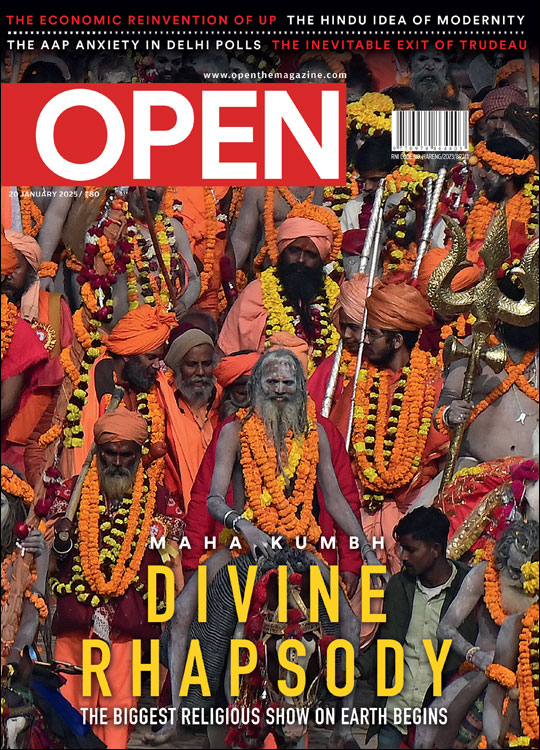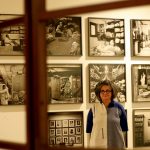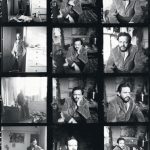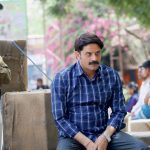In a Beautiful Labyrinth
History and memory merge seamlessly in an imaginatively curated sculpture park in the Nahargarh Fort of Jaipur
 Rosalyn D’Mello
Rosalyn D’Mello
 Rosalyn D’Mello
|
17 Jan, 2018
Rosalyn D’Mello
|
17 Jan, 2018
/wp-content/uploads/2018/01/Beautiful.jpg)
AS THE AJMER Shatabdi wound its way through open plains, offering glimpses of the historic vestiges of the Aravalli hills interspersed with yellow- speckled vistas of mustard fields, I found myself contemplating the Grecian notion of the memory palace. It was my reading of Rebecca Solnit’s Wanderlust: A History of Walking that had precipitated my journey to this conceptual cliff point, motivating me to retrace the countless times in the past ten or more years I had made the similar journey to Jaipur; groggy- eyed because of the 6 am departure from the New Delhi railway station, yet alert thanks to the anticipatory nostalgia-inducing bread-omelette breakfast. The purpose of each trip was always cultural, either the literature festival or more recently, Jaipur Photo, an annual festival of photography held in cahoots with the Rajasthan government. This time round, I was going to preview the ambitious sculpture park at the Madhavendra Palace nestled within the Nahargarh Fort, at the opposite end of the ridge from its more famous cousin, the Amer Fort.
‘There is a very practical sense in which to trace even an imaginary route is to trace the spirit or thought of what passed there before,’ Solnit writes. ‘At its most casual, this retracing allows unsought memories of events to return as one encounters the sites of those events.’ The memory palace, in her estimation, was a means of committing quantities of information to memory, ‘an important skill before paper and printing made the written word replace the memory for much storage of rote information’.
It was twilight when I made my way up the ridge towards Nahargarh Fort, having spent the day visiting other new initiatives that suggested cumulative evidence of Jaipur’s emerging status as a creative capital. The sky was clad in an intense shade of indigo. As the climb got steeper, the city seemed to spread itself out to the edges of the horizon. This vertiginous approach would become part of the mnemonic structure. Peter Nagy, founding co-director of Delhi-based contemporary art gallery, Nature Morte, and curator of The Sculpture Park, India’s first in such a historic setting, would embed it into one’s experience of walking, forging a more contemporary alliance between landscape and the palatial nature of the destination. ‘Until the surroundings became important, the walk was just movement, not experience,’ Solnit writes in her chapter ‘From the Garden to the Wild’. The taxi offered accelerated access to what would otherwise have been a long trek up desolate wilderness. Could Nagy ensure The Sculpture Park compensated for the experience of the on-foot approach that the 21st century tourist has sacrificed in the interest of time-saving conveyances? What could it mean to have contemporary artworks placed within the environs of a structure originally envisioned and constructed by Maharaja Sawai Jai Singh on the cusp of the 19th and 20th centuries as a pleasure palace, a royal zenana, with a series of seven apartments, including a triple-width one for the Rajput Maharaja himself, and six identical duplex suites for his queens? Elsewhere, Nagy had referred to the Madhavendra Palace as a proto- modernist structure “rigid in its geometric symmetries and heavyset countenance”. Would The Sculpture Park simply be a backdrop for the staging of non site- specific contemporary artworks, or would their inhabiting of the space engender an alternative form of historical presence or revival? Would his curatorial intervention assert narrative continuity between the city’s past, present and future possibilities, given that there was no prescribed theme governing the display, at least none to which one had prior access?
To deceive is to allege a certain reality under premises that undercut said reality. There’s a double-crossing involved, a betrayal between appearance and truth. My suspicions had been aroused upon sighting an image that accompanied the invitation to the preview. Huma Bhabha’s larger-than-life 2011 sculpture, God of Some Things, had been superimposed such that it occupied the floating centre of the Madhavendra Palace courtyard, its symmetrical alignment resonating with those of the photo-shopped-in venue. The image suggested insertion as curatorial strategy. ‘For most of my career as a gallerist and curator I have been trying to break away from the white-box exhibition space,’ read a quote by Nagy in the release. ‘With this project, I am able to indulge my passions for art, architecture and décor into a marvellous synthesis of the past and the present.’ I was sceptical.
Would Peter Nagy’s curatorial intervention assert narrative continuity between the city’s past, present and future possibilities, given that there was no prescribed theme governing the display?
At the opening, Bhabha’s sculpture was firmly grounded off centre in the same courtyard represented in the reference image, but no longer isolated, instead, in close proximity to Subodh Gupta’s colossal 2003 work, Doot, essentially an aluminium-cast replica of the English translation of the title, ‘ambassador’, and Bharti Kher’s choleric, phlegmatic, melancholy, sanguine (2009-17), a monumental bronze containing the female identities of warrior, goddess, witch and angel, all fused into one eclectic being, as if originating from the same source. Scale had been pre-configured into each of these three works, and Nagy was clearly playing with their respective deceptive material qualities. At first— untrained—glance, Bhabha’s work seems wood-carved and totemic, but the caption clearly states its cast-bronze attributes. No representative photograph of the sculpture can easily do justice to its texture and its statuesque nature. Though non-religious, this god seems to epitomise the fragility of one’s memory of pleasure as something rough-hewn yet exquisite, its naked tactility reads like an invitation to touch, feel, explore, as if to rekindle a previously unfelt ancestral connection. That it is taboo to touch only adds more nuance to our visual delight. This evocative presence is shared by Gupta and Kher’s works, both of which play with the spectator’s gaze by proposing to be one thing—in Gupta’s case, a humble silver ambassador car, while in Kher’s, fluid bodily appendages in a suspended state of movement—while in fact, upon closer inspection and reading, encompassing multiple significations.
In framing these relatable, colossal and spectacular sculptures, including Thukral & Tagra’s 2017 Memorial: a & b (wings), which initially appears like an ancient monolith but was intentionally created as a selfie-point for viewers who are instructed to pose between the wings, thus commenting on a populist trend by indulging in a form of populism, Nagy successfully introduces one of the show’s implicit organising principles, to re-locate the Madhavendra Palace by re-situating it as a sensorial pleasure maze for the 21st-century visitor. In doing so, he manages not to take away from the seriousness of his endeavour or the high-quality nature of the work, but to tease the viewing visitor by baiting her through deception, then seducing her into the joyous act of wanderlust.
Nagy’s curatorial talent becomes more obvious as you venture further indoors. He plays with the repetitious nature of the palace’s symmetrical duplex interiors and labyrinthine corridors. As soon as the body registers the persistent evenness of architectural detail within the spatial layout, the mind is tricked into a state of déjà vu, triggering a recent memory of having already been there, with one major difference: the art is different. Nagy has programmed the experience such that a visitor can’t help feel like she’s either entering the same room or approaching it over and over again. Yet, each occasion is unique because the different installations within the same seeming space have an individual and specific aura. You are compelled to rely on architectural details as aide-memoires, and your travels through the convoluted interiors as you prowl for the artwork as if on a treasure hunt creates a customised narrative even as it dislodges your sense of spatial reasoning.
Most first-time visitors would be hard-pressed to offer ‘directions’ to another to get to a specific work, because Nagy cleverly disorients you by encouraging you to get a little lost or to actively lose yourself, so that when you re-emerge you find that self in-between dimensions of past and present, history and memory, site and notion. You have to create your own mnemonic, upon which you will register the emotional response you will have had to the art on display. It is reminiscent of what Frances Yates writes in her The Art of Memory, which Solnit excerpts extensively in her Wanderlust: A History of Walking, about how it isn’t difficult to grasp the general principles of the mnemonic. ‘We have to think of the ancient orator as moving in imagination through his memory building whilst he is making his speech, drawing from the memorized places the images that he has placed on them. The method ensures that the points are remembered in the right order, since the order is fixed by the sequence of places in the building.’
Nagy’s talent becomes more obvious as you venture further indoors. He plays with the repetitious nature of the palace’s symmetrical duplex interiors and labyrinthine corridors
Nagy, who has been engaging with the Madhavendra Palace for more than a year, walking its corridors, mapping its reception of light and shadow, comprehending its vantage points and its metaphorical trap doors, has served us an exhibition that reveals his own oratorical experience of its uniquely historical architecture. The visitor who receives the exhibition imbibes his visual cues, thus becoming their custodian. The fact that the artworks are sculptures and not paintings is what guarantees this effect, because sculptures encompass many more dimensions than the surfaces of paintings are equipped to do, and the sculptures also dialogue with the dense networks of frescoes that line every inch of wall space including the ceiling, thus impressing themselves quite thoroughly in one’s imagination. Nagy creates a fabulous link between the way the space exists and our memory of walking through it. Unlike in a white-cube set-up where rooms are clearly mapped and demarcated by permanent or temporary walls, and where space is thus limited because it is easy to mentally survey, the Madhavendra Palace’s labyrinthine nexus of corridors, passages, rooms and ante-rooms complicates easy navigation despite how inviting and accessible they seem, and so, Nagy’s curatorial principle is deliciously focused on ensuring you devise a mnemonic for later recall. The landscape of your memory thus devises itself as a text or narrative.
IN ALL, THE Sculpture Park contains around 40 works by 24 artists from India as well as a few international practitioners such as Arman, Evan Holloway, Matthew Day Jackson, Hans Josephsohn, and Arlene Shechet. Their installation must certainly have been a challenge considering Madhavendra Palace’s status as a heritage structure, and certain works could only be assembled on site.
There are a few occasions where the link between the artwork and the room in which it is housed is so poetic, it seems like the sculptures are inhabitants, their sense of belonging and legitimacy within the space too obvious to be questioned. Vibha Galhotra’s Flow (2015), for instance, crafted from ghungroos and resembling an extensive metal mass or even a swarm of insects, seems like something semi-solid seeping down the corner of the room to spill over onto the floor. Incidentally, the ceiling in the room has a few moist patches, which makes the work ‘fit’ even better. Nagy trusts that Galhotra’s sculpture will also serve as a deceptive visual device, provoking visitors’ preconditioned notions of what a sculpture can look like as well as what it can evoke. He does the same with Gyan Panchal’s pelom 1 and pelom 2 (both 2012) that look like two cut slabs of green marble that are leaning in on two walls. It is only the bilingual wall caption that alerts visitors that the marble has been coloured by the artist with green ink so as to appear as naturally occurring. It’s a trompe-l’oeil, and it works successfully because of how casually they have been placed in a room with more minimalist frescoes. Prashant Pandey’s Peace (2015) is also composed of fragments of marble arranged in a three-dimensional sphere that from a distance appears like a white orb floating within the room, while Manish Nai’s Untitled (2017) looks like five fabricated rods resting against the centre of the room’s arch. These rods are actually composed of compressed found cloth and fabric, a technique Nai has been using for many years. Similarly, Subodh Gupta’s Stove (2013) features found utensils compressed into a rectangular block placed upon an antique stove such that their traces or scars are exposed. The work sits perhaps in too close proximity to Jitish Kallat’s Vertical Chronicle of a Turbulent Equilibrium (2013), a bamboo-and-rope-like ladder that looks like the kind used either as scaffolding or while work is in progress, but is actually made of resin. Gupta’s Stove echoes Kallat’s Annexation (2009), a larger-than-life size replica of a kerosene stove but filled with rich details of flora and fauna reminiscent of those that stud the corners and arches of Mumbai’s Victoria Terminus (renamed Shivaji Terminus).
Mrinalini Mukherjee’s bronze sculptures are at their magnificent best when just left on the floor with no pedestal. Forest Flame IV (2010) holds court in one room and revels in its verticality. The clunky, blocky grey pedestals distract from the full impact of Shivling (2014) and Bird (2012), two otherwise excellent works. Benitha Perciyal’s eerie Let them own their land (2017) is among few pieces that more directly refers to the contemporary politics of land through its titles, and the migrant identities she refers to visually. Three figures confront the viewer. One, with amputated arms, is seated while the two other more sun-tanned torsos rest on pedestals made from found wood. Perciyal has cast them in a range of materials from incense to clove and bark dust. There is an atmosphere of anticipation, like they are in waiting, but for what, we do not know, perhaps for an audience, perhaps the end of time.
Nagy’s intention is to keep the existing show on display for 11 months, after which the hang will change to possibly create an entirely new set of propositions, an exciting prospect, and one that couldn’t have been imagined in India without the government’s active cooperation. As the first of its kind in the country, there’s no doubt The Sculpture Park will find a readymade audience in the tourists who visit the fort, but more importantly, it is a significant achievement demonstrating the range of contemporary sculptural practices and the easy accessibility of the medium, despite its conceptual core.
(The works will be on display till November 2018 at The Sculpture Park at Madhavendra Palace of Nahargarh Fort, Jaipur)

/wp-content/uploads/2025/01/Cover_Kumbh.jpg)













More Columns
What does the launch of a new political party with radical background mean for Punjab? Rahul Pandita
5 Proven Tips To Manage Pre-Diabetes Naturally Dr. Kriti Soni
Keeping Bangladesh at Bay Siddharth Singh